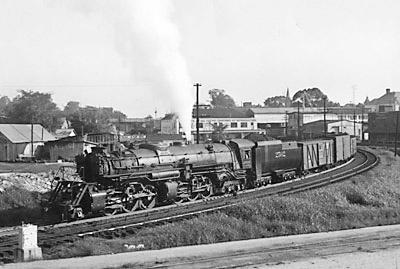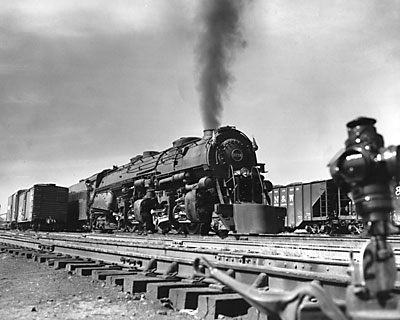But railroad locomotive superintendents grappled with an unanswered question. Could a simple articulated be designed for high-speed heavy freight service? Would an engine with 69 or 70-inch drivers be able to handle a big train over a sawtooth profile at track speeds?
Baltimore & Ohio was the first to attempt to answer these questions. In 1931, the railroad took delivery of two 2-6-6-2s from Baldwin equipped with 70-inch driving wheels.
Early testing on the Cumberland Division showed the locomotives could handle a larger train than one of the railroad’s 2-10-2s, and develop more horsepower. During these initial tests, train speeds did not exceed 35 mph. But further operation at higher speeds revealed a serious flaw: the front engine became unstable and started hunting. Armed with that knowledge, B&O put the two engines to work – but not in fast freight service.
The Great Depression slowed locomotive development temporarily, and it was not until 1935 that another fast-freight articulated was introduced. That year, Seaboard Air Line took delivery of five Baldwin 2-6-6-4s with 69-inch drivers and a tractive force of 82,300 lbs. The locomotives did not experience any front engine instability problems, and they cruised along at 60 mph or better.
The 2-6-6-4’s four-wheel trailing truck was needed to support a large, deep firebox that was placed behind the rear driving wheels. This big firebox was critical to producing the high combustion rates required for a modern high-horsepower steam locomotive.
Seaboard was very satisfied with the locomotives and ordered another five in 1937. After World War II, the railroad rapidly dieselized, and in 1947 sold its 2-6-6-4s to the B&O, where they (and B&O’s twin 2-6-6-2s) operated until 1953.
While Seaboard’s engines were the first successful high-speed articulateds, they were not the first 2-6-6-4s. That distinction belonged to the Pittsburgh & West Virginia, which received three from Baldwin in 1934.
They were equipped with 63-inch drivers and were designed for heavy freight service in the mountains between Pittsburgh and Connellsville, Pa. Their tractive effort of 82,000 lbs. was equivalent to that of a 2-10-2, and the engines developed even greater horsepower. P&WV took delivery of another four engines in 1937. The fleet lasted until the early 1950s.
N&W’s design bureau developed the Class A 2-6-6-4. The first, No. 1200, was constructed at the company’s Roanoke Shops and began a series of trials in May 1936. Testing showed the locomotive was capable of 6,300 drawbar horsepower at 45 mph. The locomotive was also very stable – even at speeds in excess of 70 mph.
A sister engine, No. 1201, came out of the shop in June. Roanoke built more Class As in 1937 and during World War II. By the time the last was delivered in 1950, a total of 43 had been built. They were the most powerful and heaviest of the 2-6-6-4s.
N&W used them as main-line freight haulers, operating from Ohio to the Virginia tidewater until 1959.
In all, sixty 2-6-6-4s were built. The last to operate was N&W No. 1218, which was rebuilt for excursion service in 1987 and ran until 1994.
N&W’s Class A garnered a host of accolades, and in the opinion of many, it was the finest steam freight locomotive ever built.















